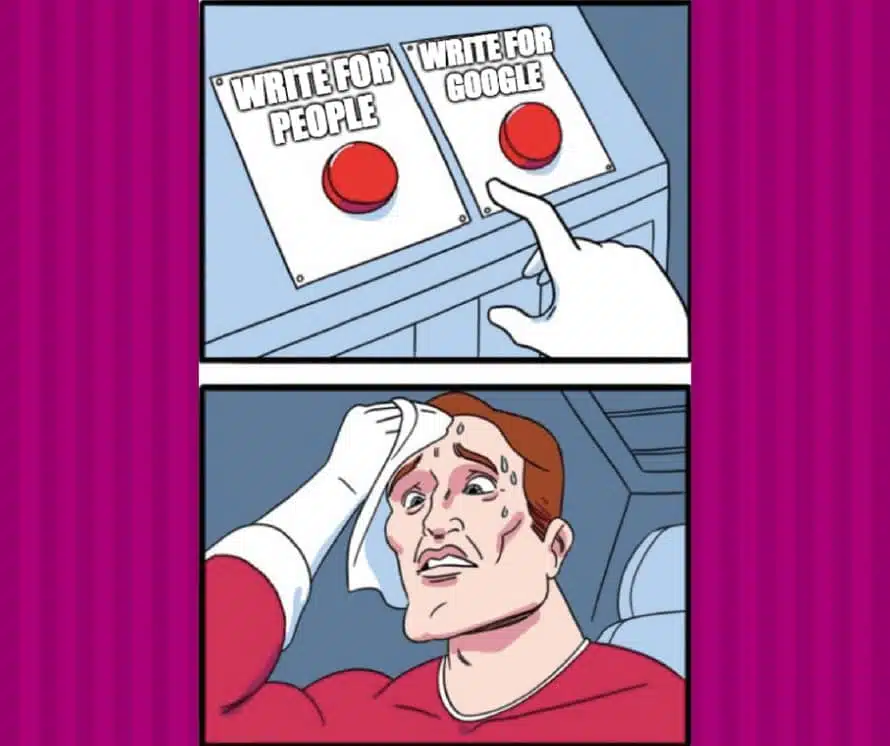Raise your hand if you’ve ever had writer’s block.
*raises hand*
I sure have.
… Spending minutes or more staring at your keyboard hoping that the creative juices will just start flowing and vomit a masterpiece of content onto your computer screen… (Gross visual, I know.)
It’s frustrating. It’s time-consuming. It’s boring. I get it.
Fortunately, it doesn’t have to be that way. In fact, you can actually PREVENT writer’s block from getting in the way of your business. And, no, I am not full of it.
I guess you could say, I have cracked the code. It only took me a few years. Ha.
So, how does one move beyond “brainstorming” content ideas and actually come up with a content plan that works?
Further, is it possible to do that without experiencing writer’s block?
Check it out, family.
Why “Brainstorming” is an Utter Waste of Time
If you have been following me for a hot minute, you know that I am all about the data. I am a strong proponent of looking at the numbers rather than trusting your gut to determine what content your audience is looking for.
Yes, having a general sense of what your audience wants and what they care about is important, but you can’t rely on it. Just like you can’t rely on keywords and leave your audience out of the equation.
But, I digress.
Wanna know how “brainstorming” is an utter waste of time?
Because even IF you think up a solid content idea, without the data, you really don’t know if it’s worth writing. You just don’t have the deets to tell you if people are looking for it.
So from an SEO perspective, you may be putting out content that isn’t really working FOR you.
And, then, you have just spent that time thinking of an idea that won’t bring you a Return on Investment (ROI) – time-wise or otherwise.
That’s not ideal.
So let’s do this another way. MY way. The data-driven, sure-as-heck-gonna-land-you-clients way. Ready for it? Let’s go!
Stop Brainstorming. There’s a Better Way.

Want to know my way of thinking up content ideas that I KNOW are going to generate leads for my business?
It all lies in having a plan.
Start Strategizing.
If you haven’t had a chance to download my Free SEO Content Roadmap, now would be a great time, as I really go in depth about how to think up content ideas and get started on SEO. Plus, did I mention it’s free? It’s almost as good as those samples at Costco.
If you have already ran through the SEO Content Roadmap… sweet! You are already a few steps ahead! So, let’s get movin’.
Like I said above, effective content planning depends on the data.
Essentially, what you want to know is:
- What is my target audience looking for?
- How many of them are looking for it?
- What is my existing content missing?
- What are my customers asking me?
- and What are my competitors doing?
Fortunately, data and research can answer ALL of these questions for you. And once you have those answers, you have all the puzzle pieces to create a strategic and effective content plan.
1. What is my target audience looking for?
A good indication of what your audience is looking for is to 1) Look at existing data for your own site and 2) look at the data from your competitors’ sites.
For #1, you will want to log into your existing Google Analytics and/or Google Search Console accounts.
If you do not have these set-up, this data won’t be available to you yet. (Learn how to set it up here.)
If they are, navigate to the following dashboards:
* Make sure you have set the date range to at least the past 3 months, preferably longer.
Google Analytics –> Aquisition –> Overview — Organic Search
Google Search Console –> Search Traffic –> Search Analytics
Both dashboards will display the keywords that your website is ranking for. Google Search Console will even show the position of your site for these terms and how many clicks it is getting.
Now, look at these terms and note which ones are relevant to your business. Make a note of these. These are all potential content opportunities.
For #2, you can use the free tool SpyFu to see what your competitors are ranking for.
Simply enter the URL for your competitor’s site in the search bar, scroll down, and see what keywords are being displayed. Again, take note of the ones that relevant to your business. You may even want to put a * by those that you think you should be sure to cover on your site that are missing at the moment.
Both of these steps will provide you with ideas (ie keywords) that you want to target. But there are still some things we gotta figure out. So let’s keep going…
2. How many of them are looking for it?
Answering this question relies on a bit of research – specifically, keyword research.
In the SEO Content Roadmap, I go into how to conduct keyword research using some of my favorite tools. But, since you are here already, let’s go into what those tools are and how to use them.
For those of you really ballin’ on a budget, I recommend getting started with the Keywords Everywhere extension. This is a free tool that allows you to see the search volume and competition level of the keywords you are trying to target.
Once you have downloaded the tool, go to Google and type in a broad term that relates to the focus of your website.
For example, this could be “website designer”, “SEO copywriter”, “Bali travel blog”, etc.
Then look at the numbers displayed underneath the search box. These numbers tell you how much search volume a keyword has and how much competition it has.
If a term has a high search volume, that means a lot of people are searching for this term. However, if the competition is also high, that means there are a lot of other sites targeting this term. That can make things more difficult.
The goal is to find a few niche-related terms that get decent search volume and have a low competition level. This is the sweet spot.
With this information, you can have more confidence in creating content around these terms, as you know people are searching for it, yet you don’t have to compete with a ton of other websites to outrank them.
3. What is my existing content missing?
It’s at this point in the process that I like to step back and try to look at my site as a whole.
I ask, “What am I missing from my site that could really help my target customers?” Further, “Are there resources that I build off of existing content to answer more of their questions?”
Since the ultimate goal is to establish yourself as an authority in your niche AND entice people to buy from you/hire you, it makes sense to inform them and keep them on your site for as long as possible.
The more you can work to create a “web” of content for them to follow, the better! This essentially leads them down a trail of information that answers as many of their questions as possible until they trust you enough to subscribe/hire you/buy.
Sometimes it can even be beneficial to have a past client (or content pro, like me!) review your site to find those gaps fo you!
4. What are my customers asking me?
This step should be an obvious one but it’s amazing how many times we forget to ask our target audience what they are looking for – or pay attention to what they are telling us.
If you have channels for feedback on your services or content (like polls, reviews,etc.), these can provide a ton of insight into what your potential customers want to see on your website.
You can also check out your engagement on your social media platforms to see the kinds of questions they are asking and struggles they are talking about. Rather than just responding to their comment and writing it off, instead, build out a piece of content that answers their question directly. Not only with this help them, but likely help a bunch of other people looking for the same information.
5. What are my competitors doing?
The last point (and my favorite, if I am being honest) is doing some good ol’ fashioned competitor analysis.
If you have no competition, well… you’re ahead of the game (or you just haven’t found them yet).
If you DO, you can reverse engineer their content strategy to find out what may work for your own.
For example, if you see that your competitor has a Testimonials page on their website, and you don’t, that may be something worth adding.
You can also guess what keywords they are targeting by looking at their page/post titles and the content on their site.
I would never suggest copying your competitors’ content ideas (for a million different reasons), but if there are any gaps that are painfully obvious, it may be worth filling them in on your own site.
And remember the data you got in Step 1? This will let you know what keywords they are ranking for as well.
This is Where it All Comes Together
By this point, you should have a handful of keywords, a bunch of numbers, and some ideas on what content you can create. So, how does it all come together?
This is where your creative and strategic brain comes into play.
You will want to look at the keywords that make the most sense for your business. You will want to look at the gaps in content between your competitors and yourself. You will also want to take into consideration what your target audience is looking for and how many are looking for it.
Very easily, you can see the recipe become:
high-volume keyword + low competition + relevancy + interest = great content idea
In other words, the keywords with high volume and low competition are a safe bet for targeting. Then, you will want to confirm that it would fit in with the focus of your site. And finally, you will want to confirm that your audience is actually searching for it.
The result is a kick-ass content idea that is both SEO-friendly AND just what your audience wants!
But you may be wondering… “How do I do this on a grand scale?”
Well, that takes practice.
If you are truly in-tune with what your audience wants, your eyes and ears will be open to key content ideas.
See a question from a past client? Write it down, validate it, answer it in your content.
Competitors just came out with a new article? Write it down, confirm it fits with your site, add your unique twist, and create some content around it.
Over time, the ideas will just start flowing naturally – and – you can rest assured knowing they are rooted in the data!
+ I personally like to keep an ongoing list of ideas in my phone, so that when it’s time to start writing, all I have to do is a bit of keyword research and I am ready to go.
You’ll never have to just sit down and stare at your screen again. (Well, unless you are binge-watching YouTube videos).
The point is, all brainstorming goes by the wayside. You have data. You have a strategy. You have ideas.
Then, you’ll just have to put your fingers to the keyboard!
Want to Learn More?
Still a little apprehensive about thinking up your own content ideas? No worries!
For one, be sure to download my Free SEO Content Roadmap for even more details
OR
Send me a message to schedule your own strategy session with me!
I’m happy to help!




